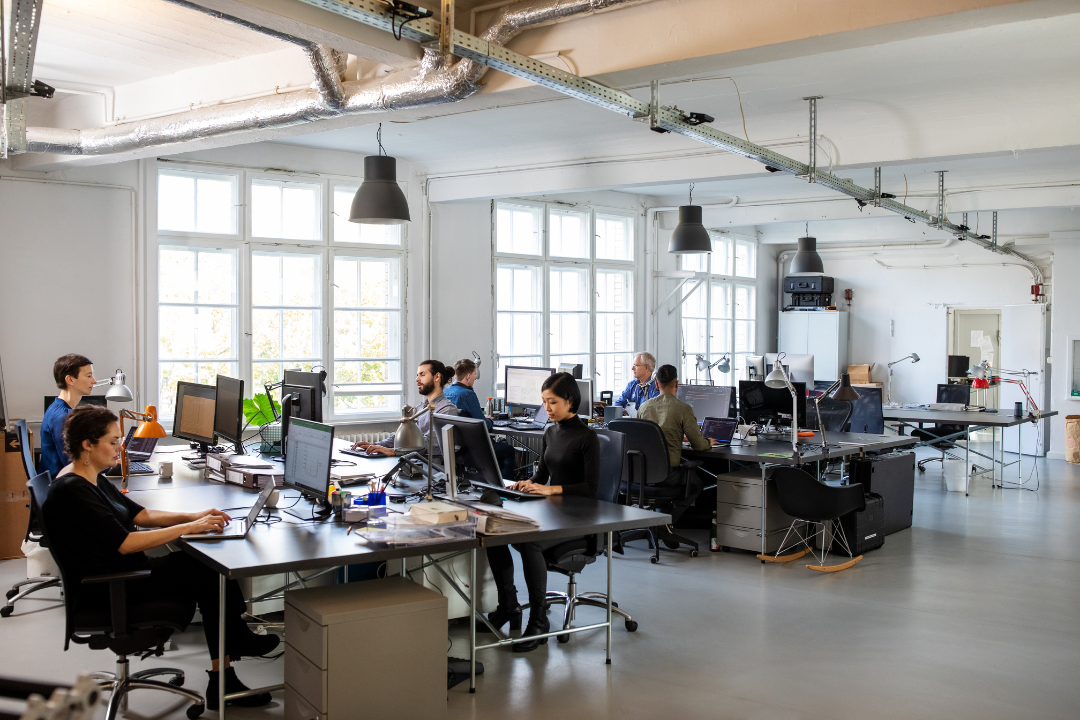Hot desking can be liberating, but only when it’s managed with precision. When it isn’t, things unravel quickly. Desks become scarce, meetings run over, and employees feel displaced. According to workplace surveys, nearly half of hot desking rollouts fail in the first year because policies, systems, and expectations are unclear.
The idea is simple: share the same desks to reduce wasted space and real estate costs. But in practice, it takes planning, communication, and the right technology to make it work. Let’s look at how to implement hot desking successfully, step by step.
A well-managed hot desking setup can dramatically increase how efficiently you use your office space, allowing every square foot to support real collaboration instead of sitting empty. It also reveals the benefits of hot desking, such as improved space utilization, stronger collaboration, and reduced real estate costs.
Pick Your Hot Desking Model (This Matters More Than You Think)

Your hot desking model shapes everything else. It determines how people book desks, how the space feels, and how flexible the experience really is. Choose wisely.
When implementing hot desking, the first decision is which model best suits your culture and team dynamics. The structure you choose will define how easily people adapt and how consistent your office experience feels.
First-Come-First-Served Hot Desking
This is the most fluid version of hot desking. People arrive, find an available hot desk, and settle in for the day.
It works beautifully in small offices of fewer than fifty people, where attendance varies and culture values independence. It supports hybrid workplace models with minimal structure and high trust.
It fails when unpredictability causes stress. Large teams or those with many in-office days struggle to find seats. People start showing up earlier just to secure a hot desk.
The key to success is capacity. Always maintain about twenty to thirty percent of desks unoccupied each day. That buffer prevents frustration and keeps the experience positive while keeping office space flexible enough to meet daily fluctuations.
Hotel Desk Booking (Advance Reservations)
Hotel desking allows employees to reserve desks ahead of time. It feels organized and predictable.
It works well for structured teams and planners who like to know where they’ll sit before leaving home. It gives managers visibility into who’s in and helps coordinate meetings and collaboration spaces.
It fails when spontaneity is part of daily work. People who make last-minute decisions can feel blocked by the need to reserve.
The key factor is the booking window. Experiment with one to seven days in advance to find what keeps desks accessible without cluttering the calendar.
Hybrid Model (Mix of Both)
Most organizations find balance in a hybrid approach. Allocate sixty to seventy percent of desks as reservable, while keeping thirty to forty percent open for walk-up use.
This blend gives planners peace of mind and leaves space for impromptu visits. It fits well with mid-sized companies managing flexible work environments and evolving attendance patterns.
The hybrid hot desking model is often the most resilient because it satisfies both certainty and choice. When done well, it becomes a blueprint for optimizing office space around actual behavior instead of assumptions.
Choose Desk Booking Software That Actually Works

If we try to run hot desking through spreadsheets or emails, it will collapse. Successful hot desking depends on a reliable desk booking system that removes friction. Let’s define what that means.
Must-Have Features (Non-Negotiable)
A desk booking solution must include:
- Visual floor plans. People need to see where each hot desk and meeting room is. Text lists create confusion.
- Mobile app and web access. Both are essential. Employees book differently depending on where they are.
- Calendar integration with Outlook, Google, Teams, or Slack to align reservations with meetings.
- Check-in and automatic cancellation to handle no-shows.
- Real-time desk availability that updates instantly.
- Visibility of who’s in the office, which helps teams coordinate and plan together.
Integration Requirements
The best desk booking software fits seamlessly into existing workflows.
It must connect with tools already in use, such as Teams, Slack, or email. It should offer single sign-on to make adoption effortless. Badge access integration is ideal for check-ins.
If employees have to leave their normal tools to reserve or check in, participation will drop. Integration is the difference between compliance and genuine engagement.
Set Up Your Booking Rules and Policies

Clear policies turn flexibility into function. Without rules, the system loses credibility. Here’s how to build a framework that keeps everyone aligned.
A strong policy framework also simplifies implementing hot desking at scale. When expectations are documented and shared early, employees adjust faster and the transition feels intentional rather than disruptive.
Policies also ensure that your office space stays balanced between predictability and freedom, keeping everyone comfortable no matter their work style. Establishing a clear hot desking policy helps employees understand what’s allowed, how to book, and how to behave in shared environments.
Booking Windows and Limits
Decide how far in advance people can reserve a hot desk. Testing a three- to seven-day window often works best.
Set limits on consecutive booking days to avoid desk hoarding. Some companies allow up to three days in a row, with recurring reservations only for roles that require routine presence.
Establish a cancellation deadline to free up unused desks. Transparency keeps the process fair for everyone.
Check-In Requirements
Define what it means to actually occupy a desk.
Provide a grace period of fifteen to thirty minutes for late arrivals. After that, the system should automatically cancel the reservation and return the desk to the pool.
Offer flexible check-in methods: QR codes, app-based confirmations, Wi-Fi detection, or badge readers. Each option should feel natural.
When people don’t check in, the policy must be clear: their desk becomes available again.
Clean Desk Policy
Hot desking only works when every desk feels ready for the next person.
At the end of each day, employees should clear all personal items and confidential documents. Food and drinks should not remain overnight. Provide cleaning supplies at every station.
This simple ritual preserves order and maintains a professional office environment. It also reduces cleaning time and ensures every desk is equally welcoming.
Solve the Ghost Booking Problem
Ghost bookings are reservations that no one uses. They make desks appear full when they’re not, creating false scarcity. The only way to eliminate them is through automation and accountability.
Implement Automatic Check-In Systems
Require employees to check in within fifteen to thirty minutes of their reservation start. The system should cancel any no-show automatically.
Support multiple check-in options: mobile app, QR code, Wi-Fi detection, or badge swipe. Send gentle reminders before the reservation starts.
This process keeps your desk usage data accurate and makes every available desk visible again in real time. It also ensures your office space data reflects real occupancy instead of assumptions.
Track and Address Repeat Offenders
Use workplace analytics to spot people who repeatedly book but don’t show up. Introduce a soft warning system at first. If behavior doesn’t change, apply booking limits or escalate to managers.
When everyone understands that accountability is part of the system, participation improves naturally. Transparency builds trust.
Handle Peak Demand Days
Every office has its crunch days. Usually midweek, desks and meeting rooms reach capacity, while Mondays and Fridays remain quiet. Managing these peaks is essential to maintaining a positive hot desking experience.
Identify Your Peak Days
Start with data. Analyze attendance over several weeks to find patterns. In most hybrid workplaces, Tuesday through Thursday are the busiest.
Plan for eighty to ninety percent maximum occupancy on those days. Always keep a small buffer to prevent overcrowding.
Company-wide events or quarterly meetings also create spikes. Predict them and prepare additional seating zones or alternate locations.
Overflow Solutions
Have a plan for overflow. Convert large meeting rooms into temporary desks when needed. Use breakout areas or partner coworking spaces as backups.
Communicate clearly when the office is near capacity. Some teams deserve priority, such as those whose roles require in-person collaboration.
Stagger anchor days between departments to spread demand evenly through the week. These small adjustments reduce stress and keep office space usage efficient and predictable. A flexible hot desking policy should define how to prioritize teams on these high-demand days.
Optimize Your Office Layout for Hot Desking

A flexible system works best in a thoughtful space. Office layout influences comfort, productivity, and collaboration more than people realize.
When implementing hot desking, it’s worth rethinking how zones, storage, and circulation support daily habits. A well-designed layout makes flexibility intuitive instead of confusing. It also ensures every square meter of office space contributes to active use. The benefits of hot desking become much clearer when the layout supports collaboration and flow.
Create Office Neighborhoods/Zones
Group desks by team, department, or work type. Quiet areas support concentration, while collaborative zones encourage movement and conversation.
Label every zone clearly on the floor plan and inside your booking system. Employees should be able to filter by zone when booking.
This organization maintains team connection and reduces friction between different work styles. It also makes the space feel more personal, even without assigned seating.
Equipment Standardization
Every desk should be ready for immediate use. That means consistent equipment: monitor, docking station, keyboard, mouse, and reliable power access.
Aim for ten to twenty percent standing desks to accommodate different preferences. Provide specialty equipment in designated areas, such as dual monitors or privacy screens.
Label desks in the booking system with available equipment so employees can find what they need easily. Nothing kills enthusiasm like arriving to discover a missing cable.
Quiet Zones vs. Collaborative Zones
Establish clear behavioral rules for each area. Quiet zones are for focused work, no calls or conversations. Collaborative zones allow meetings, calls, and informal teamwork.
Use signage and booking policies to reinforce the distinction. Provide phone booths for private calls to keep noise under control.
This division maintains harmony and helps everyone find their ideal working rhythm.
Solve the Personal Storage Problem
When people no longer have a permanent desk, storage becomes the next challenge.
Locker Strategy
Give every employee access to a locker. Treat it as essential, not optional. Lockers should be large enough for a laptop, jacket, and personal belongings.
Place them near the main hot desking areas so people can store items conveniently. Choose whether lockers are permanently assigned or day-use. Either way, they anchor the hot desking workspace in a tangible way.
What Employees Can/Can't Bring to Desks
Encourage small personal touches that humanize the space: a photo frame, a small plant, or a notebook.
Discourage overnight storage, food, and confidential papers. By the end of the day, everything should go home or into a locker.
Provide portable desk caddies to make packing up easy. These small habits keep shared desks clean, available, and pleasant for everyone.
Keep Teams Connected

Hot desking can unintentionally isolate teams if left unchecked. Fortunately, a few simple practices prevent that drift.
Team Anchor Days
Designate certain days when whole teams come in together. It creates rhythm and consistency without reverting to assigned seating.
Use the desk booking system’s “who’s in office” visibility so colleagues can coordinate their visits. The ability to book alongside teammates keeps collaboration alive.
Just be careful not to over-regulate. Too many mandatory anchor days undermine the flexibility that makes hot desking valuable.
Enable Team Clustering in Neighborhoods
Create zones where departments can sit together when they’re in. For cross-functional projects, designate temporary project zones.
This arrangement helps people stay close to their collaborators without reverting to permanent desks. It also improves communication and reinforces belonging in an open office environment.
Use Workplace Analytics to Actually Improve
A good hot desking system doesn’t just manage space. It teaches us how to optimize it. Data is what turns hot desking from a tactical change into a strategic advantage.
For organizations implementing hot desking for the first time, analytics provide the feedback loop that guides improvement. Without data, decisions revert to guesswork.
Analyzing office space utilization weekly reveals which areas thrive and which remain underused. That insight fuels continuous improvement.
Key Metrics to Track Weekly
Track these metrics every week to keep your workspace healthy:
- Desk utilization rate: booked versus actual occupancy. Aim for sixty to eighty percent. Lower means too many desks; higher means too few.
- No-show rate: should stay under ten percent.
- Peak demand days and times: identify which zones and hours are busiest.
- Zone popularity: which areas attract the most activity.
- Check-in completion rate: target above ninety percent.
- Booking-to-occupancy ratio: should stay within five to ten percent.
- Cost per occupied desk: compare to the old assigned model to measure cost savings.
Monthly Analysis & Adjustments
Review trends each month. Adjust booking windows, desk-to-employee ratios, and equipment distribution. Identify underused zones and redesign them.
Analyze how your new hot desking strategy impacts real estate costs, space utilization, and employee satisfaction. The best results come from steady, incremental adjustments.
Quarterly Strategic Reviews
Every quarter, gather feedback through surveys. Measure satisfaction alongside utilization data. Present insights to leadership to justify space decisions and demonstrate impact.
Use these reviews to fine-tune your workplace strategy. Add or remove desks, adjust policies, or plan expansions and reductions based on real data rather than assumptions.
You've Got the Strategy: Now Get the Software That Executes It
Hot desking is not just a seating plan. It’s an operational system that balances flexibility, efficiency, and human experience.
To manage it successfully, we need four non-negotiable elements: the right desk booking software, clear policies, analytics-driven optimization, and consistent communication with employees.
Managing all of this manually is almost impossible. Automation through modern workplace management software separates functional hot desking environments from dysfunctional ones.
That’s where elia comes in. elia is designed specifically to handle the real challenges of hot desking: ghost bookings, peak-day chaos, team coordination, and space analytics. It integrates directly into your existing tools, connects to your calendar, and provides an intuitive floor plan view that lets everyone book hot desks, meeting rooms, and collaboration spaces in seconds.
If you’re ready to transform your office into a truly flexible and efficient workspace, book a demo and see how elia can solve your specific hot desking challenges. Because managing shared desks shouldn’t be complicated. With the right technology, it just works.


.png)
%20(1).png)
![Return to Office Policy Template: Complete Guide + Free Template [2025]](https://cdn.prod.website-files.com/64f88f68249f7cafe071d150/6904cddc5762e4cdd787a51b_blog%20images%20-%20elia%20(34)%20(1).png)
![Workplace Security Policy Template: Free Download & Implementation Guide [2025]](https://cdn.prod.website-files.com/64f88f68249f7cafe071d150/68f8ea97387c070f0356f265_blog%20images%20-%20elia%20(33)%20(2).png)